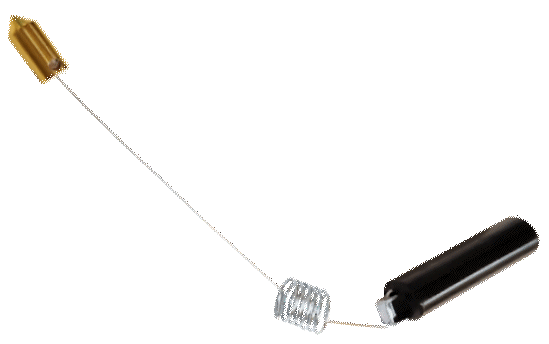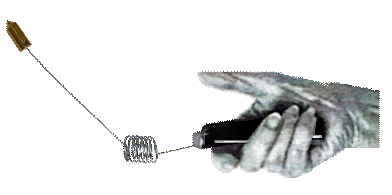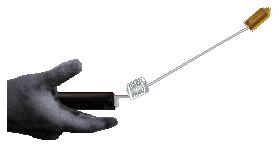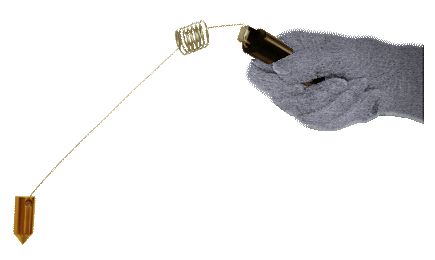The Aurameter Dowsing Rod is a professional multi-use dowsing rod originally invented by Verne L. Cameron back in the 1930s.
The Aurameter which Verne perfected in 1952 is a five-in-one dowsing rod. The Aurameter is considered by other dowsers to be one of the most sensitive dowsing instruments on the market.
$110.00 Original price was: $110.00.$99.99Current price is: $99.99.
The Verne L. Cameron Aurameter Dowsing Rod, also known as the “Water Compass” was originally invented by Verne L. Cameron (1896–1970) in the 1930s. In 1926 he began dowsing and honed his skills by locating springs and water wells for neighbors. He also wrote about dowsing and subtle energies.

The Aurameter which Verne perfected in 1952 is a five-in-one dowsing rod. The Aurameter is considered by other dowsers to be one of the most sensitive dowsing instruments on the market.
The Aurameter is a compass, pendulum, pointer, wand and counting mechanism.
This professional dowsing rod is of durable construction. It has an adjustable brass head, flexible, sturdy steel wire construction fitted to a plastic grip.
The Original Cameron Aurameter is a multi-functional, multi-directional rod that replaces the need for L-rods, V or Y rods, Bobbers and pendulums.
The Aurameter has a vertically adjustable head that allows for a variety of positions. This provides the dowser with several options when taking readings.

Verne L. Cameron is considered as being one of the most talented dowsers in recent history. He first discovered dowsing in 1926. Within a year he had located several water well sites and springs for neighbors. His astounding professional work brought him international fame.
As its name suggests, the Aurameter was initially designed to detect human auras, acupuncture points, and other body energy systems. However, this rod is a capable tool for dowsing for water, oil, minerals or buried treasure. Many dowsers use the Aurameter for map dowsing.
The Aurameter detects emanations from persons, animals, objects, physical and non-physical. The Aurameter moves on several axis points and the lead and head can move sideways, up and down in a bobbing manner. The rod can move circularly and oscillates, making this a versatile dowsing tool.
You can order his book here.
Stand erect, relaxed and focused. Hold the Aurameter Dowsing Rod lightly and do not use a tight grip when holding the handle.
The Aurameter has five dowsing functions:

Hold the Aurameter Dowsing Rod with your palm turned semi-upward. This is the ideal handling mode for seeking answers to questions. Use your prearranged mental programming for your “yes, no, and neutral” response.
Ask your question from your logical, reasoning mind. By using your pre-programmed dowsing system intuitive information from the person, creature, objet, substance or thing is accessible, even at a distance extending the limitations of the five senses.
The Aurameter Dowsing Rod can be gripped in either hand. For increased sensitivity, the Aurameter is held with your palm turned semi upward. This is known as the “Side-Grip.” It is the ideal handling mode for seeking answers to questions. These are first framed in your logical, reasoning mind. Then, using your prearranged code,
intuitive information from the person, creature, object, substance or thing, may be gained at a distance, enabling
one to exceed the limitations of the five senses.
When you hold the Aurameter with the palm facing downwards, the over-grip position enables you to maintain greater physical control over the rod. This comes in handy for specific dowsing tasks.

Hold the Aurameter with the palm facing upwards. It elevates the coil spring and tip higher, thereby increasing sensitivity. Use the under-grip when responses are weak.
Grip the handle half-way back so that your index finger doesn’t contact the coil-spring wand, placing a drag on its free sideways and up-down movements. This drag will nullify the counter-balancing action between the wand and tiny coil spring mounted inside of the handle. It is this free movement that achieves the Aurameter’s ultra sensitive dowsing reactions.
Bring the Aurameter Dowsing Rod into position with the coil spring-want and tip slanting downward and pointing directly forward so that gravity helps to establish a natural starting balance.
Once the wand-tip is forward-centered, slowly raise the rod upward. This is achieved by bending your wrist, but do not elevate your forward at this time. At some point, the Aurameter will find its “poise” position. At this point, it’s difficult to sustain the pointer upward and directly forward. If it falls to the right, or left, out of control, you’ve gone too far. The “poise” position is critical for maximum response. The higher you raise the coil-spring wand pointer without losing balance, the greater the sensitivity.
This higher raised position is helpful when lower elevated responses are sluggish. When the wand and pointer slant downward, the added weight at the tip creates inertia, but when the assembly is elevated above level with the floor or horizon, this is the ideal searching mode.
Through the law of sympathetic attraction, subtle energies make contact with the object of one’s search. After sustained contact, the Aurameter Dowsing Rod registers replies by means of your pre-arranged dowsing program. For example, “Yes” indicates with a right swing and “No” with a left swing. If the wand pointer fails to swing fully over to the right or left, this indicates “uncertain,” or “maybe”.
You can also develop answers using numbers or letters of the alphabet by bobbing the wand-pointer up and down. When the wand-pointer swings over the rod indicates arrival at the last number or letter or inquiry.
When following the path of a vein or any other energetic structure, push against the edge of it–do not allow the Aurameter to get into the L rod search position because when it does that, it is very easy to lose contact with the vein or energy line.
Advantages: it is excellent at defining outer perimeters of energy fields, or for following underground veins of primary water, or other less than straight energetic phenomena.
Here’s a YouTube link by Bill Cox, a respected dowser showing how to use the Aurameter Dowsing Rod.

The Aurameter Dowsing Rod is an ingenious device serving five distinct dowsing functions, replacing the need for L- or Swing Rods, Wands, Pendulums, and Forked Switches.
34 cm / 88 gm – (13.39″ / 3.10 oz)
Note: The Aurameter Dowsing Rod tip is adjustable. However, sometimes it becomes loose and doesn’t stay in position. If that’s the case, use a screwdriver and gently tighten the screw accordingly.
Another sensitive and easy to use dowsing rod is the Bobber Pro.
| Weight | .088 kg |
|---|---|
| Dimensions | 34.0 × 4.0 × 4.0 cm |
Reviews
There are no reviews yet.